Sony E 16-50mm f/3.5-5.6 OSS Lens Review
Sony E16-50mm f/3.5-5.6 OSS Performance
At 16mm, sharpness is already excellent in the centre of the frame at maximum aperture. Unfortunately the same cannot be said about the clarity delivered towards the edges of the frame at maximum aperture for this focal length, which can only be considered fairly good. Stopping down the aperture improves sharpness across the frame, with peak clarity being achieved between f/5.6 and f/8, where sharpness in the centre remains excellent, and good to very good towards the edges of the frame.Zooming to 28mm results in a slight drop in sharpness in the centre of the frame, but improvements are made towards the edges at maximum aperture, where clarity reaches good levels. Just the same as at 16mm peak sharpness is achieved between f/5.6 and f/8 for this focal length.
Finally, at 50mm overall sharpness is reduced further, as is common with many zoom lenses. Even so, sharpness is still very good in the centre of the frame at maximum aperture, and very good across the frame at f/8.
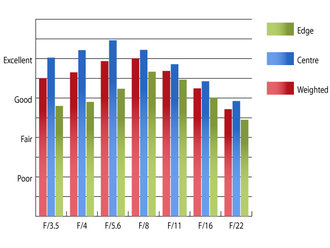 Resolution @16mm | 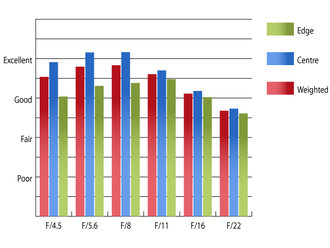 Resolution @ 28mm | |
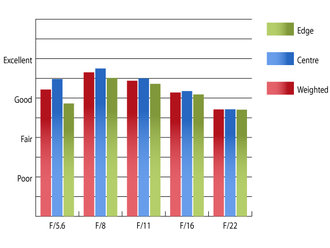 Resolution @ 50mm | How to read our chartsThe blue column represents readings from the centre of the picture frame at the various apertures and the green is from the edges. Averaging them out gives the red weighted column.The scale on the left side is an indication of actual image resolution. The taller the column, the better the lens performance. Simple. For this review, the lens was tested on a Sony NEX-6 using Imatest. |
Chromatic aberrations are well controlled, barely exceeding half a pixel width at most apertures and focal lengths. CAs just exceed three quarters of a pixel width towards the edges of the frame with the lens stopped to f/22 throughout the zoom range and at maximum aperture at 50mm. On the whole, fringing shouldn't pose too many issues, but care may need to be taken with high contrast subjects when using f/22 or shooting at 50mm and f/5.6.
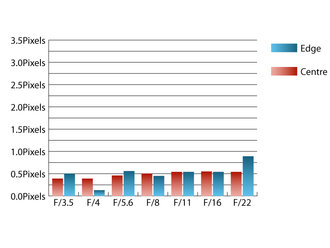 Chromatic aberration @ 16mm | 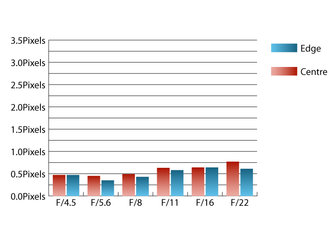 Chromatic aberration @ 28mm | |
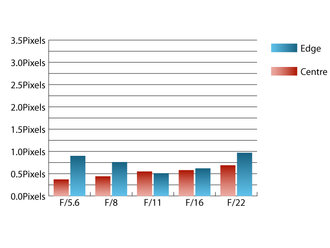 Chromatic aberration @ 50mm | How to read our chartsChromatic aberration is the lens' inability to focus on the sensor or film all colours of visible light at the same point. Severe chromatic aberration gives a noticeable fringing or a halo effect around sharp edges within the picture. It can be cured in software.Apochromatic lenses have special lens elements aspheric, extra-low dispersion etc. to minimize the problem, hence they usually cost more. For this review, the lens was tested on a Sony NEX-6 using Imatest. |
Falloff of illumination towards the corners of the frame is reasonable for a lens with a slow maximum aperture. At 16mm the corners of the frame are 1.6 stops darker than the image cetre and visually uniform illumination is achieved with the aperture stopped down to f/5.6. At 50mm the corners are only 1.1 stops darker than the image centre and visually uniform illumination is achieved with the aperture closed down to f/8.
Distortion is well controlled for a lens of this type. Peculiarly, stronger barrel distortion is present at 50mm than could be detected at 16mm. Imatest detected 0.875% barrel distortion at 16mm and 1.86% at 50mm. If absolutely straight lines are required, you'll be glad to know that the distortion pattern is uniform across the frame, which should make applying corrections in image editing software afterwards relatively straightforward.
Although this lens is reasonably resistant to flare, shooting into the light can result in contrast being visibly reduced. Due to the compact design of the lens, no lens hood is supplied, as this would make the lens more bulky.
Add your message
Login required
Please login here or if you've not registered, you can register here. Registering is safe, quick and free.
Please login here or if you've not registered, you can register here. Registering is safe, quick and free.
photodo Stats
1102 lenses
428 MTF tests
74 in-depth photodo reviews
100+ users join each day
Help the lens community by reviewing or rating a lens today via our lens search
428 MTF tests
74 in-depth photodo reviews
100+ users join each day
Help the lens community by reviewing or rating a lens today via our lens search
Latest Lens Reviews
- Chinon 28mm f/2.8 Vintage Lens Review
- Canon EF 70-200mm f/4L IS II USM Lens Review
- Samyang AF 85mm f/1.4 EF Review
- Sigma 70mm f/2.8 DG Macro Art Review
- Samyang AF 24mm f/2.8 FE Review
- Meike 50mm f/1.7 Review
- Tamron 70-210mm f/4 Di VC USD Review
- Lensbaby Burnside 35mm f/2.8 Review
- Asahi Super Takumar 50mm f/1.4 Review
- Asahi Super-Multi-Coated Takumar 135mm f/3.5 Review
